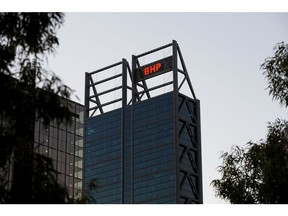Article content
(Bloomberg) — BHP Group Ltd. said first-half profit slumped 23% as China’s faltering economy dampened demand for iron ore, prompting the miner to cut its interim dividend to an eight-year low.
BHP Group Ltd. said first-half profit slumped 23% as China’s faltering economy dampened demand for iron ore, prompting the miner to cut its interim dividend to an eight-year low.

(Bloomberg) — BHP Group Ltd. said first-half profit slumped 23% as China’s faltering economy dampened demand for iron ore, prompting the miner to cut its interim dividend to an eight-year low.
Article content
Article content
The biggest miner posted underlying attributable profit for the six months to Dec. 31 of $5.08 billion, it reported Tuesday. That was below analyst estimates of $5.39 billion. Iron ore remains the company’s biggest earner — but only just — with copper now accounting for 44% of its revenue.
Advertisement 2
Story continues below
Article content
BHP’s move to cut its dividend to 50 cents a share, down from 72 cents the year before, will reinforce speculation the board has a renewed focus on capital management as it pursues growth. Analysts were anticipating a dividend of 53.3 cents.
The slip in profits continues a trend for BHP since it posted record earnings of $33.1 billion for the year to June 2022 as iron ore demand soared. Annual profits have since more than halved, with declining capital returns and rising capital expenditure weighing on its shares.
Still, Chief Executive Officer Mike Henry struck a positive tone in Tuesday’s statement. “The demand for BHP products remains strong despite global economic and trade uncertainties, with early signs of recovery in China, resilient economic performance in the US and strong growth in India,” he said.
BHP’s shares, which initially edged higher in Sydney following the announcement, were down 0.6% at 10:10 a.m.
Benchmark iron ore prices dipped 5% during the reporting period, while copper fell 9%.
The mining giant’s iron ore mines in Western Australia’s Pilbara were hit by Tropical Cyclone Zelia last week. The company said that while it was maintaining its forecast output of the steelmaking material from the region of between 282 million tons and 294 million tons for the year to June 30, it no longer expects production to be in the upper half of the range due to the impact of the storm.
Article content
Advertisement 3
Story continues below
Article content
Analysts from Citigroup Inc. and Jefferies Financial Group Inc. have flagged that this year will be one where major miners’ primary focus will be on capital allocation, with a particular emphasis on expanding portfolios of commodities central to the energy transition, such as copper.
Ongoing capital expenditure pressures will be a key focus of incoming chairman Ross McEwan, who will succeed outgoing Ken MacKenzie after he served in the role since September 2017.
During MacKenzie’s tenure, BHP focused on higher investor returns to ensure investor confidence, overseeing the divestment of a vast oil and gas portfolio and a large chunk of the company’s coal business. More recently, he steered the company back to inorganic growth with the acquisition of Australian copper play OZ Minerals Ltd. in 2022 and last year’s failed $49 billion takeover attempt of Anglo American Plc.
China’s Challenges
Adding pressure to the iron ore business are ongoing macroeconomic challenges in China. Despite attempts by Beijing to stabilize its debt-ridden property sector, the nation’s economic recovery remains brittle.
Advertisement 4
Story continues below
Article content
The top metals consumer is also yet to feel the sting of tariffs leveled by the US. Just two weeks ago, President Donald Trump signed executive orders imposing tariffs of 10% across the board on all imports from China.
“China recently reiterated a pro-growth policy stance with more accommodative monetary and proactive fiscal measures,” BHP said in its economic outlook. “In the face of external trade uncertainty, policymakers have vowed to boost domestic demand via several measures that should support steel and metals-related manufacturing demand.”
India continues to be a “bright spot” for commodity demand, it said.
BHP sees copper as one of its most important growth areas, along with potash used to manufacture fertilizer, as China’s demand for steelmaking material iron ore plateaus.
During the reporting period, BHP announced it would spend at least $10 billion to maintain and grow copper production across its Chilean portfolio over the next decade and a half. It will spend at least $4 billion at its Escondida copper mine alone.
Mines such as Escondida, where BHP has an operational 57.5% interest alongside Rio Tinto Group, are aging and deposits of such size and scale are rare. In January, BHP completed its acquisition of Filo Corp. with partner Lundin Mining Corp., which owns the Filo Del Sol mine in Chile. BHP’s 50% stake in Filo cost around $2.1 billion.
(Updates with details throughout.)
Article content
Comments